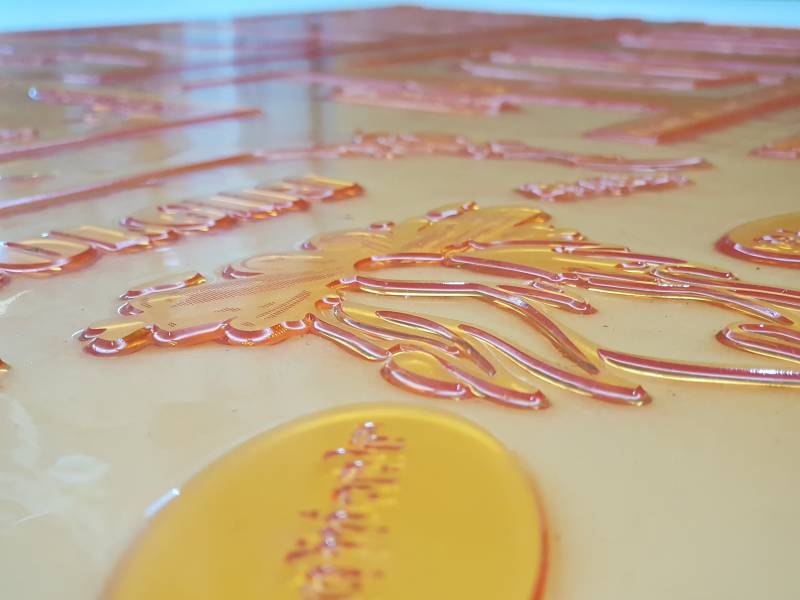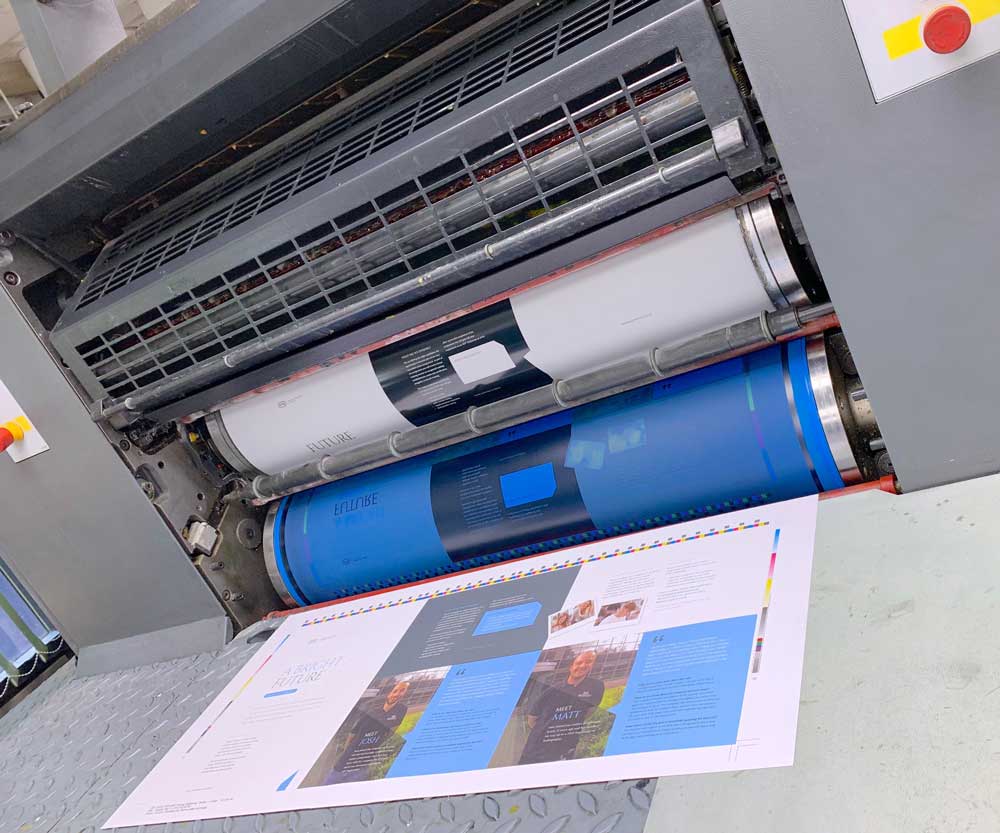Corrugated Carton Production Tools
- Khobre Mihan co
- Article
- Corrugated Carton Production Tools
Table of Content
Corrugated Carton Production Tools
Tools used in the production of corrugated carton at Khobre Mihan Company for printing include cliché (Flexo printing) and zinc (offset printing).
Corrugated Carton Printing Tools
Corrugated Carton is a popular choice for packaging in the industry due to its affordability, environmental compatibility, lightweight and high strength compared to other packaging materials such as plastic, wooden boxes, and metal boxes. For this reason, corrugated carton has become the first choice for most industries to pack their products.

Cliche
The main method of printing cardboard is flexo printing, which is done by a tool called a printing plate. One of the most important steps before printing for cardboard is cliché making.
One of the advantages of flexo printing is that this method can print different colors on porous layers and also on smooth and polished surfaces. In other printing methods, several colors of ink are needed to achieve the desired color and clarity, but in flexo printing, because a fast-drying ink is used, several different colors can be printed on the desired surface at short intervals.
The use of a properly quality cliché is one of the most important pillars of producing cardboard with high-quality flexo printing. Clichés are produced in various types, each with its own specific applications.
Types of clichés:
Gelatin clichés: These are used in corrugated cardboard making and flexo printing. They are made of a durable material, such as steel or photopolymer, and are coated with an ink-receptive layer.
Digital clichés: These are used in flexo printing. They are made of a thin sheet of metal, which is coated with a photosensitive emulsion. The emulsion is exposed to light, which creates a negative image of the desired image or text. The metal is then developed, which leaves a raised image that is ink-receptive.
Silk screen clichés: These are used in silk screen printing. They are made of a thin sheet of fabric, which is coated with a photosensitive emulsion. The emulsion is exposed to light, which creates a negative image of the desired image or text. The fabric is then developed, which leaves a hole-pattern that is ink-receptive.
Tampo clichés: These are used in tampography. They are made of a flexible material, such as rubber or silicone, which is coated with an ink-receptive layer.
Metal clichés: These are used in gold leaf printing. They are made of a thin sheet of metal, which is coated with a gold leaf.
The choice of the appropriate cliché type depends on the desired printing method, the type of substrate, and the desired image or text.
Zinc
Lithography is one of the stages of offset printing, in which metal sheets made of aluminum, also known as zinc or plate, are made. Zinc is a technical term in the printing industry in Iran for the equivalent of Printing Plate. In English, zinc (Zinc) means the metal “zinc”.
The designed files are initially converted into lithographic plates, which are then transferred to a printing press. In this process, the lithographic plates are transformed into metal sheets. The surface of these metal sheets is made of materials that do not absorb ink. Instead, the polymer material used to print the design onto the zinc plate is ink-receptive. Through the interaction of these metal sheets, the desired design is transferred onto the registration plate. Subsequently, the printing process takes place on paper at the printing house.

Tools used in Cutting Corrugated Carton
Another category of tools used in the corrugated packaging carton production process is die-cutting tools, known as dies.
Die-cutting is a method through which the process of cutting cardboard, corrugated board, metal sheets, paper, and even various types of plastic into specific shapes is accomplished. Using a die-cutting machine, a product with a particular shape can be produced repeatedly and consistently without the need for other tools like scissors, templates, and cutters. The use of die-cutting machines results in time savings, and the cut cardboard pieces will be entirely uniform.
Types of die-cutting dies include:
Platen Die Cutting
Flat die cutting dies are produced in a flat and plate-like shape and are installed on a flat die cutting machine.
Flat die cutting is one of the most widely used machines in the box and cardboard manufacturing industry. Flat dies are made without dimensional restrictions using laser and standard blades, which include a wooden plate, cutting blades, bending blades, and various perforations. These dies can cut various types of cardboard, cardboard, self-adhesive papers, laminated papers or foam and cardboard or magnets into different shapes and preferences in a flat die cutting machine.
These dies are also used in industrial production processes for leather, linoleum, various foams, fabrics, and other similar items. The main advantage of flat die cutting is the appropriate accuracy and the possibility of producing boxes with very small dimensions.
Platen Die Cutting Advantages
Flat die cutting dies are versatile tools that offer several benefits, making them a valuable asset in various industries. Their precision ensures consistent and accurate cuts, while their repeatability guarantees consistent results over time. Additionally, their speed allows for efficient production, and their flexibility enables them to handle a wide range of materials and shapes.
Platen Die Cutting Disadvantages
However, flat die cutting dies come with a few drawbacks. Their initial cost can be substantial, and the cutting process inevitably generates waste. Despite these limitations, their advantages often outweigh their disadvantages, making them a popular choice for various applications.
Platen Die Cutting Application
Flat die cutting dies are extensively used in the packaging industry for cutting boxes, cartons, and other packaging materials. They also play a crucial role in the printing industry for cutting labels and other printed materials. Moreover, their versatility extends to industrial manufacturing, where they are employed to cut various materials for diverse purposes.
In summary, flat die cutting dies offer a combination of precision, repeatability, speed, and flexibility, making them an indispensable tool in various industries.
Read more: Carton box
Rotary Die Cutting
This type of die is made up of a wooden base and multiple cylindrical layers that are used in rotary cutting machines. This new technology is very efficient in the production process of cardboard and corrugated boxes, and it allows for cutting cardboard sheets in different sizes, into various shapes, and at high speeds.
One of the most outstanding advantages of rotary die cutting is that it leaves very little waste from the cardboard edges.
Ping-Pong Die Cutting
In this die cutting method, the dies are made in a flat shape. This type of die cutting is known as ping-pong die cutting due to its resemblance to a ping-pong table. In the cardboard production process using ping-pong die cutting, the corrugated cardboard sheet is placed on the die and the machine is turned on by pressing the start button. Then, the die moves to the opposite side and passes under a Teflon roller. The pressure of the Teflon roller on the sheet causes the blades of the die to cut the sheet into desired shapes.
Flat Dies (Embossing Dies)
In addition to cutting, bending, or perforating blades, these dies also include embossing parts. This type of die allows for embossing on cardboard simultaneously with cutting.
Die-cutting boxes is one of the key steps that must be performed with great precision and delicacy in order to make the pre-press and printing processes usable. This die-cutting method is widely used in the production of luxury cardboard boxes with embossing.
Flat embossing dies are used to cut and emboss cardboard at the same time. This method is often used to create luxury cardboard boxes with raised designs.
We help our customers stand out in the market by providing superior packaging solutions
To achieve this goal, we continuously invest in developing our relationships with our customers so that we can meet the needs of our customers today and tomorrow. The consulting and design team of Mehen’s expert engineers, after hearing the demands of the customers, examined the different ways of packaging the product and then using the valuable experiences of the past and the current knowledge of packaging and the use of new technologies, the most optimal type of packaging examined. provides to consumers. For more information and consultation with us, click on the free consultation button.

